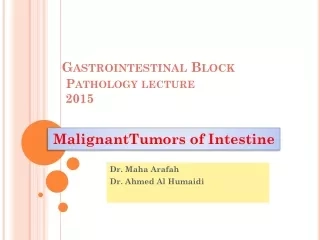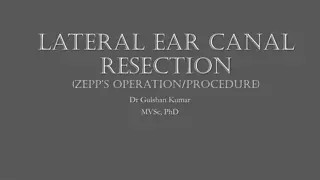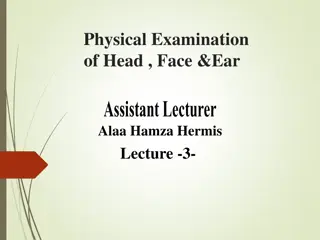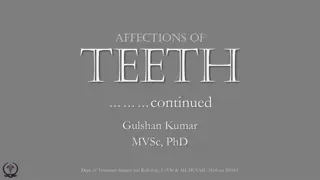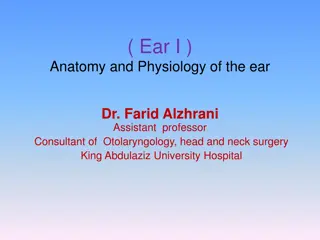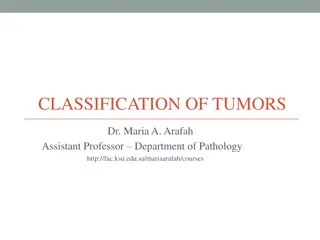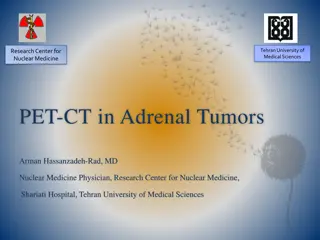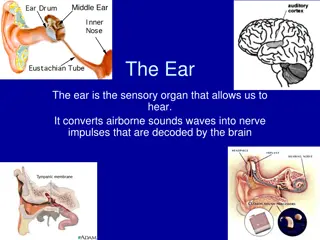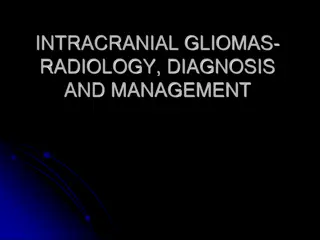MalignantTumors of Intestine
This lecture discusses the epidemiology, pathology, and prognosis of malignant tumors of the intestine, with a focus on colon cancer. It covers the different stages of colorectal adenocarcinoma, the relationship between CEA and recurrence, and the significance of carcinoid tumors.
4 views • 40 slides
Zongertinib Trial in HER2 Aberrant Tumors
Zongertinib (BI.1810631) Phase I Study in Advanced Solid Tumors with HER2 Aberrations focusing on NSCLC. The trial involves dose escalation and expansion, testing different doses in cohorts with varied HER2 mutations. Primary endpoints include MTD, OR, and DLTs.
2 views • 14 slides
Understanding Tumor Classification and Nomenclature in Pathology
This slideshow provides an overview of tumor classification, nomenclature, and key concepts in pathology. It covers the definitions of neoplasm, tumor, and oncology, the classification of tumors into benign and malignant categories, as well as the importance of stroma in tumor behavior. It also expl
4 views • 61 slides
HER2 Tyrosine Kinase Inhibitor Zongertinib Phase Ia/b Trial in Solid Tumors
Study on Zongertinib, a HER2 tyrosine kinase inhibitor, in patients with HER2 aberration-positive solid tumors. The trial involves multiple centers worldwide and aims to evaluate the efficacy of Zongertinib in treating various cancers harboring HER2 mutations. Financial disclosures of lead investiga
1 views • 13 slides
Pharmaceutical Technology Lab: Nasal and Ear Drops Formulations
Learn about the formulation and use of nasal and ear drops in pharmaceutical technology labs. Explore details on nasal drops for nasal passages, ephedrine nasal drop recipe, notes on ingredients, ear drops for ear care, sodium bicarbonate ear drop recipe, and procedures for preparation. Understand t
2 views • 13 slides
neurosurgeon in jaipur-Dr Himanshu Gupta
brain tumor is an abnormal growth of cells in the brain. Tumors can be either cancerous (malignant) or non-cancerous (benign). Cancerous tumors grow and spread aggressively, potentially invading nearby tissues and spreading to other parts of the body, while non-cancerous tumors are usually less aggr
0 views • 5 slides
Understanding Glue Ear in Children and Young People
Glue ear is a condition where the middle ear fills up with fluid, causing temporary hearing loss. It is important to be aware of the signs of glue ear, such as speaking loudly, asking for repetition, and finding it hard to concentrate. The impact of glue ear can affect physical comfort, balance, spe
0 views • 15 slides
Understanding Testicular Tumors: Types, Classification, and Clinical Findings
Testicular tumors are predominantly malignant, with germ cell tumors being the most common type. This article delves into the classification of testicular tumors, including primary and secondary, benign and malignant, germ cell, and non-germ cell tumors. Clinical findings such as painless enlargemen
3 views • 31 slides
Ear Cropping: Overview, Procedure, and Legal Status in Veterinary Practice
Ear cropping is the surgical procedure of removing part or all of a dog's pinnae or ear flap. While banned in many countries, it remains legal in specific breeds for certain purposes. This detailed guide covers the introduction, indications, age requirements, surgical process, post-operative care, a
0 views • 14 slides
Understanding Grading and Staging of Malignant Tumors in Cancer Patients
Grading and staging are crucial in determining the aggressiveness and extent of malignant tumors. Grading involves assessing the level of malignancy based on cell differentiation and mitotic activity, while staging considers the size of the tumor, lymph node involvement, and presence of metastases.
7 views • 31 slides
Otitis Externa: Overview, Risk Factors, and Treatment
Otitis externa, also known as swimmer's ear, is an inflammation of the external auditory canal. It can be acute or chronic and is common among individuals aged 7-14 years. The main causative organisms include Pseudomonas aeruginosa and Staphylococcus aureus. Risk factors include swimming in pools, h
0 views • 10 slides
Management of Symptomatic Ear Wax in Adults: Olive Oil Drops vs. Alternative Solvents
Adults (>18 yrs) presenting with symptomatic ear wax often seek interventions like olive oil drops or alternative ear wax solvents. A study compared the efficacy of olive oil drops in conjunction with syringing versus alternative treatments or no treatment. PubMed search yielded 26 papers, with 2 re
5 views • 12 slides
Comprehensive Overview of Parotid Tumor Diagnosis and Management
This comprehensive guide covers the diagnosis and management of parotid tumors, including anatomy, differential diagnosis, and management strategies. It discusses the approach to evaluating patients with neck lumps, differential diagnoses to consider, and the management techniques for both benign an
0 views • 20 slides
Understanding Gamma Knife Stereotactic Radiosurgery
The Gamma Knife Stereotactic Radiosurgery is a precise and effective treatment method where highly focused radiation beams are used to target tumors and abnormalities in the brain. It does not remove the tumor directly but affects DNA, cell growth, and blood vessels. The procedure involves three mai
0 views • 51 slides
Lateral Ear Canal Resection (Zepp's Operation) by Dr. Gulshan Kumar
Lateral ear canal resection, also known as Zepp's operation, is a surgical procedure performed by Dr. Gulshan Kumar, MVSc, PhD. This operation involves the removal of a portion of the lateral ear canal to treat various ear conditions. The images show different stages of the procedure, providing a vi
0 views • 6 slides
Guide to Safe and Effective Ear Cleaning for Pets
Learn how to safely clean your pet's ears with step-by-step instructions, images, and tips. Discover the anatomy of the ear, identify ear problems, and understand the materials needed. Follow safety precautions and ensure your pet's comfort during the cleaning process.
0 views • 8 slides
Understanding How the Ear Works and Common Issues
The ear functions for hearing and balance, with the cochlea for hearing and semicircular canals for balance. Sound waves are funneled through the pinna, vibrate the eardrum, pass through the ossicles, and move fluid in the inner ear to transmit nerve impulses. Important terms include auditory cortex
0 views • 19 slides
Overview of Middle Ear Infections: Microbiology, Classification, and Risk Factors
Middle ear infections, known as otitis media (OM), are common, especially in infants. The microbiology, anatomy, classification, epidemiology, pathogenesis, and risk factors of middle ear infections are discussed in detail. Factors like URTI, allergies, and exposure to pathogens contribute to the de
0 views • 22 slides
Ear-Related Ages: Exploring the Connection Between Age and Ear Health
Exploring the ages of 4, 14, 24, 34, 54, 74, and 84 years old in relation to ear health with references to research articles from J. Vestib. Res. This collection examines the impact of age on ear-related conditions and provides insight into maintaining ear health across different stages of life.
0 views • 28 slides
Comprehensive Physical Examination of Head, Face, and Ear
This content provides detailed guidance on conducting a thorough physical examination of the head, face, and ear. It covers objectives such as safely completing the examination, documenting assessment data accurately, and evaluating findings. The preparation, general approach, and specific inspectio
0 views • 21 slides
Understanding Neuroendocrine Tumors: Endocrinology Insights
Delve into the complex world of neuroendocrine tumors (NETs) through a detailed presentation prepared by Dr. Thomas O'Dorisio from the University of Iowa. Explore case reports, therapeutic interventions, and the challenges associated with managing these tumors. Gain valuable insights into the functi
0 views • 24 slides
Veterinary Dental Conditions and Tumors: A Comprehensive Overview
This detailed information covers various dental affections and tumors in veterinary medicine, discussing conditions like dental fistula, odontoma, ameloblastoma, and epulis. It provides insights into the causes, characteristics, and classifications of these oral health issues, offering valuable know
0 views • 9 slides
An In-depth Look at the Anatomy and Physiology of the Ear by Dr. Farid Alzhrani
Delve into the comprehensive insights provided by Dr. Farid Alzhrani, Assistant Professor and Consultant of Otolaryngology, Head, and Neck Surgery at King Abdulaziz University Hospital, on the intricate details of the ear's anatomy and physiology. Explore topics such as the external ear structures,
0 views • 41 slides
Understanding Neoplasia: Characteristics and Nomenclature of Tumors
Neoplasia, or new growth, is characterized by uncoordinated growth exceeding that of normal tissues, persistent growth independent of stimuli, loss of responsiveness to growth controls, and local expansion regardless of host environment. Tumors are classified into benign and malignant categories in
0 views • 36 slides
Histiocytic Neoplasia in the Heart: A Rare Case Report
A 3-year-old girl presented with persistent fever, leading to the discovery of a cardiac mass diagnosed as histiocytic neoplasia through imaging and biopsy. Primary cardiac tumors are rare in children, with benign tumors being more common. Histiocytic sarcomas are malignant neoplasms with characteri
0 views • 10 slides
Classification of Tumors: A Comprehensive Overview
Understanding the classification of tumors is crucial in the field of pathology. This detailed overview covers the definitions of neoplasia and tumors, the differentiation between benign and malignant tumors, nomenclature, and characteristics of various tumor types. It discusses the behaviors of ben
1 views • 34 slides
Understanding Pancreatic Cancer: Facts, Tumors, and Risk Factors
Pancreatic cancer, a deadly disease, is on the rise with specific risk factors like age, genetics, and lifestyle choices. Exocrine and endocrine tumors differ in presentation and treatment. Learn about the pancreas's location, statistics, and crucial risk factors associated with this malignancy.
0 views • 19 slides
Understanding PET-CT Imaging in Adrenal Tumors at Tehran University
Tehran University of Medical Sciences' Research Center for Nuclear Medicine specializes in PET-CT imaging for adrenal tumors. Dr. Arman Hassanzadeh-Rad, MD, explains the principles of PET imaging, hybrid imaging combining PET and CT, F-18 FDG use, SUV measurement, and more. PET-CT allows for both at
0 views • 21 slides
Epidemiology and Pathology of Brain Tumors - Overview and Incidence Statistics
This information provides an in-depth overview of the epidemiology, classification, and pathology of brain tumors. It covers the relative incidence of various brain tumors, including astrocytoma, glioblastoma, meningioma, and others. The data also includes statistics on the occurrence of brain tumor
0 views • 98 slides
Understanding How the Ear Works - A 6th Grade Science Guide
The ear is a complex organ divided into three main parts: the outer ear, middle ear, and inner ear. Each part plays a crucial role in the process of hearing. Vibrations travel through the outer ear canal, vibrate the eardrum, and pass through the tiny bones of the middle ear to reach the cochlea. Ha
0 views • 8 slides
Exploring the Physics of Hearing and the Incredible Mechanics of the Ear
Discover the fascinating world of hearing and speech communication, delving into the intricate workings of the human ear. From the importance of speech and hearing for human interaction to the inner mechanisms of the ear's ability to convert sound waves into electrical signals for the brain, this ex
0 views • 29 slides
Understanding the Anatomy of the Ear
The ear is a complex sensory organ that enables us to hear by converting sound waves into nerve impulses processed by the brain. It consists of the outer, middle, and inner ear, each playing a crucial role in the hearing process. Changes in air pressure can affect the ear, causing discomfort that ca
0 views • 17 slides
Understanding the Human Ear: Structure, Function, and Adaptations
Explore the intricate structure of the human ear, its role in hearing, and adaptations for sound absorption. Learn about the functions of different ear parts, from the pinna to the auditory nerve, in converting sound waves into nerve impulses for interpretation by the brain.
0 views • 14 slides
Understanding Ear Tumors and Cholesteatoma: Causes, Symptoms, and Management
Ear tumors such as Glomus tumor and Acoustic neuroma can affect vital functions of the ear, leading to symptoms like tinnitus, vertigo, hearing loss, and facial nerve disorders. Surgical excision is a common treatment method. Cholesteatoma, an abnormal skin growth in the middle ear, can also cause c
0 views • 13 slides
Understanding Ear Wax (Cerumen) and Its Management
Ear wax, also known as cerumen, is a yellowish waxy substance secreted in the ear canal to protect, clean, and lubricate. Excess ear wax can lead to hearing issues, such as partial loss or malfunction of hearing aids. Learn about the types of ear wax, symptoms of blockage, and safe methods of remova
0 views • 9 slides
Evaluation of MURR Thermal BNCT Facility for Canine Nasal/Sinus Tumor Treatment
The study evaluates the MURR Thermal BNCT Facility's effectiveness in treating canine nasal/sinus tumors using a phantom. The facility, located at the University of Missouri Research Reactor, offers Boron Neutron Capture Therapy (BNCT) under the direction of Dr. Fred Hawthorne. Key features include
0 views • 21 slides
Overview of Salivary Gland Tumors and Diseases
Salivary gland diseases, including tumors, can affect both major and minor glands. These tumors may be benign or malignant, with common benign tumors like pleomorphic adenoma. Clinical features of salivary gland tumors vary, with slow-growing benign tumors being more common. Pleomorphic adenoma is p
0 views • 27 slides
Overview of Renal Tumors: Benign and Malignant Forms
Explore the spectrum of renal tumors, from benign papillary adenomas and oncocytomas to malignant renal cell carcinomas like clear cell carcinoma. Images and descriptions showcase the gross pathology and histopathology of these tumors. Learn about the features and prognosis of different renal tumor
0 views • 31 slides
Intracranial Gliomas: Radiology, Diagnosis, and Management Overview
This comprehensive overview covers the classification, subtypes, and spatial definitions of intracranial gliomas, including astrocytic tumors, oligodendrogliomas, ependymal tumors, neuronal tumors, pineal tumors, and embryonal tumors. It also discusses low-grade gliomas and spatial definitions based
0 views • 38 slides
Symptomatic Control of Functioning Pancreatic NET
Pancreatic neuroendocrine tumors (panNETs) can be classified as functioning or non-functioning, with functioning tumors producing active hormones such as insulin, glucagon, gastrin, or VIP. Symptomatic control is crucial for managing these tumors, with diagnoses based on clinical syndromes and hormo
0 views • 19 slides
